| Columns Retired Columns & Blogs |
May be JM could also review the B&W Formation Duo wireless speakers, under $5,000/pair, including stands ...... B&W also sells Formation Audio, a Connect like box for additional $700 :-) ......
I first looked at the behavior of the Piega Connect wireless control unit, using my Audio Precision SYS2722 analyzer. Measured at its analog output jacks in variable mode, this had a maximum gain of 0.3dB. The fixed mode offered the same 0.3dB gain. The analog input clipped at 2.2V. A 1kHz signal at –12dBFS at the coaxial and optical digital inputs resulted in a level at the analog outputs of 534mV, suggesting that the Connect's gain architecture is very similar for both analog and digital signals. Both digital inputs locked on to data sampled at rates from 44.1kHz to 192kHz, but when I looked at the frequency response with a 192kHz stream, it appeared that the data were downsampled to 96kHz (fig.1).
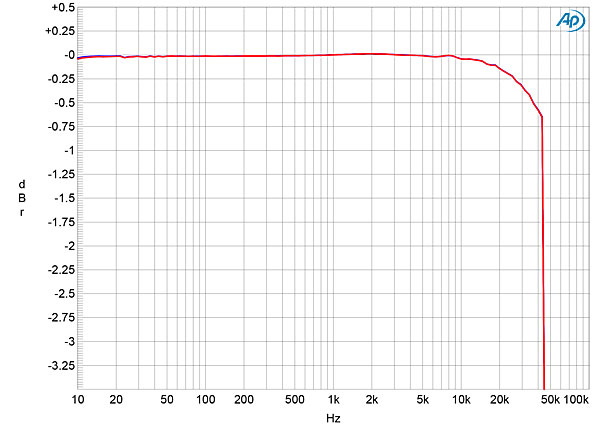
The analog input impedance was 14k ohms from 20Hz to 20kHz. The analog output impedance was a usefully low 460 ohms, and the Connect preserved absolute polarity. Channel separation was >110dB at all audio frequencies. Distortion just below clipping was very low, with the third harmonic the highest in level at just –96dB (0.0015%).
Turning to the Wireless 701 loudspeaker, I used DRA Labs' MLSSA system to measure the farfield behavior with a calibrated DPA 4006 microphone. Because Julie Mullins had performed most of her critical listening with the magnetically attached grille in place, the farfield measurements were performed with the grille. I then repeated some without the grille. For the speaker's nearfield responses, I used an Earthworks QTC-40 mike, which has a small ¼"-diameter capsule that doesn't obstruct the radiation from the woofers or port. I performed all the acoustic measurements using the loudspeaker's analog input, which appears to have a high input impedance, then repeated some tests via Wi-Fi from the control unit.
I found an anomaly with the Wi-Fi connection. The Connect and speakers can be linked with three different networks, labeled white, blue, and red. These colors correspond to the color of the LEDs on the three products' rear panels. I started measuring using the white Wi-Fi connection, which is the factory-default setting. However, the measurements were limited to a bandwidth of 24kHz, ie, a sample rate of 48kHz. Checking the manual revealed that the white and blue connections are limited to 24/48k data and that only the red connection would operate at a 96kHz rate. I therefore rebooted the Connect and the 701 speakers so that they were linked with the red connection. The system's Wi-Fi frequency was set to 5.2GHz, which Piega recommends using "whenever possible." The bandwidth was still limited to 24kHz, however, even though I checked that I was sending 24/96k data to the Piega Connect via TosLink.
Piega doesn't specify the 701's sensitivity. I found that sending a 100mV MLS signal to the speaker's analog input resulted in an spl of 85.3dB(B) at the 50" microphone distance I use for my farfield measurements. The Wireless 701s will play very loudly with full-scale digital data.
When I investigated the enclosure's vibrational behavior with a plastic-tape accelerometer, I found some modes on the sidewalls (fig.2). The highest in level was at 305Hz, with lower-level modes at 203Hz, 355Hz, and 1200Hz. Because these modes all have a very high Q (Quality Factor), they might not have much of an effect on the speaker's sound quality.
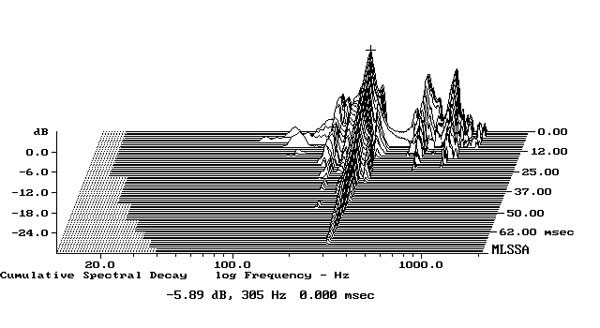
The black trace above 300Hz in fig.3 shows the Piega 701's farfield response, averaged across a 30° horizontal window centered on the tweeter axis. The response in the upper midrange and low treble is flat, though there is then a slight lack of energy apparent in the presence region and a slight excess in the octave between 5kHz and 10kHz. This measurement was made with the grille; repeating it without the grille had no effect on the response below 8kHz but resulted in 3–5dB more energy in the top audio octave. Removing the grille also eliminated the slight peak at 20kHz.
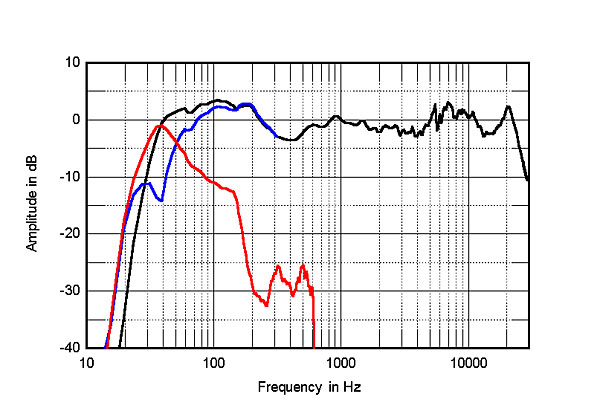
The two woofers behave differently. The lower woofer rolls off gently above 150Hz, leaving the upper woofer to continue up to the crossover frequency to the tweeter. The blue trace in fig.3 shows the sum of the nearfield woofer outputs. Its minimum-motion notch, which is when the back pressure from the port resonance holds the cones stationary, lies at 39Hz. The nearfield response of the port (red trace) peaks broadly between 30Hz and 60Hz, with a clean upper-frequency rolloff.
The black trace below 300Hz in fig.3 and 5 shows the sum of the Piega's nearfield woofer and port outputs, taking into account acoustic phase and the different distance of each radiator from a nominal farfield microphone position. The usual excess of upper-bass energy due to the nearfield measurement technique is evident, but the lower midrange is still shelved down by around 3dB. This is something you often see in so-called two-and-a-half–way designs. The summed output rolls off rapidly below the port tuning frequency due to the presence of a high-pass filter to protect the relatively small woofers from being overloaded at subsonic frequencies.
These nearfield measurements were taken with the 701's rear-panel switch set to Neutral. Setting it to Wall shelved down the outputs of the woofers and port by around 2dB below 120Hz. Setting it to Corner increased the reduction in low-frequency level by up to 5dB, with the turnover frequency increased to 200Hz.
The Piega's horizontal radiation pattern, with each off-axis response normalized to the response on the tweeter axis, is shown in fig.4. The upper woofer becomes directional at the top of its passband, indicated by the gully centered on 2kHz in the output to the speaker's sides. The tweeter's dispersion at the bottom of its passband is wide, but the drive-unit then becomes very directional above 8kHz. In the vertical plane (fig.5), a suckout centered on 3.9kHz appears more than 5° above the tweeter axis, which is 38" from the floor. The Piega maintains its tweeter-axis response over a ±5° vertical window, however.
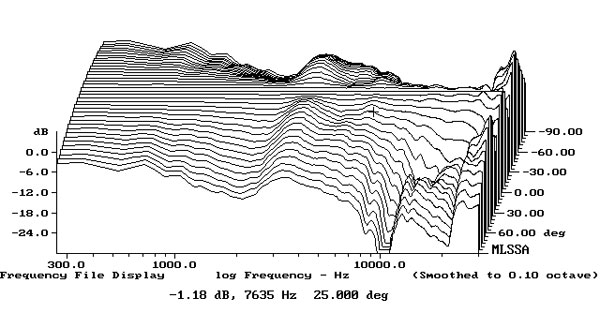
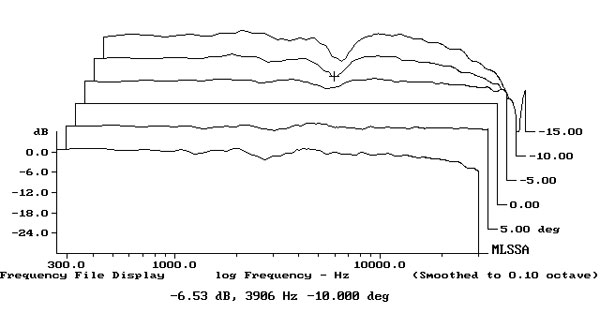
In the time domain, the Piega 701's step response on the tweeter axis (fig.6) indicates that all three drive-units are connected in positive acoustic polarity. The tweeter's step arrives first at the microphone, and the decay of the 701's step is overlaid with high-frequency ringing, which correlates with a ridge of delayed energy just below 6kHz in the Piega's cumulative spectral-decay plot (fig.7). (As always with my CSD plots, ignore the small ridge just below 17kHz, which is due to interference from the computer monitor's line-scan frequency.) This plot was taken with the grille in place. Removing it didn't change this behavior.
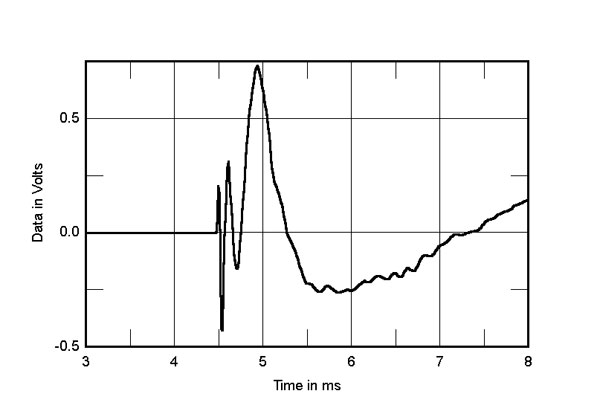
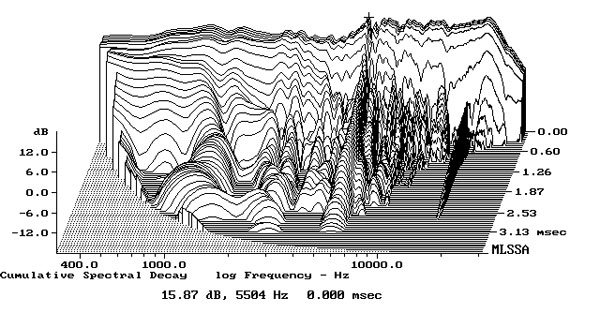
Though the Piega Premium Wireless 701's on-axis balance has too much mid-treble energy, this can be adjusted by experimenting with toe-in.—John Atkinson

May be JM could also review the B&W Formation Duo wireless speakers, under $5,000/pair, including stands ...... B&W also sells Formation Audio, a Connect like box for additional $700 :-) ......

It might have been intetesting to compare active to passive, this "Piega Premium Wireless 701" active DSP filtered loudspeaker compared to the "Piega Premium 701" conventional passive loudspeaker connected to suitable electronics with neutral sonic character.

True ... The ribbon tweeter in this Piega seems to have some problems as the measurements show ..... B&W Formation Duo uses conventional dome tweeter ..... B&W may not show those tweeter problems :-) ......

B&W formation Duo is also about $2k less expensive, (even adding the Formation Audio box) than the Piega wireless speakers :-) .....

Hi Bogolu, thanks for your suggestion. I'd be interested in hearing this system.

Is that wheeled cart with all those bottles in the JM's listening room? :-) .......

Haha. No, it isn't. That photo was supplied.

One of the most intriguing speakers out there, and would be a real treat to get Piega to submit a pair for review. Hopefully it would perform better on the CSD than this one did, though.
As a side note, it takes 8 hours to hand assemble just one coaxial drive unit!

https://www.stereophile.com/content/piegas-new-loudspeaker

I think normalizing to response on tweeter axis is not good, especially because the response on tweeter axis is not shown to readers. What is shown to readers is an alleged on-axis response averaged across 30° horizontal window.

Once you have got used to hi-res music, and have a system that uses high frequency time-accurate reproduction, you would not want to go back to the low bandwidth and jitter introduced by using a TOSLink connection to push digital audio, rather than using a USB audio connection to pull audio, jitter free.

We can use any external DAC's analog output, and connect it to the analog input of Piega Connect box's analog input ....... The DAC's USB input can be connected to the source's USB output ...... There are numerous external DAC's available at many different price points on the market ........
For CDs, they can be ripped to a server/computer and that source's USB output can be connected to the external DAC's USB input .......
A CD/SACD player analog output can be connected to the Connect box's analog input :-) ........

"Extrusion can yield a seamless, curved cabinet, with no right angles or hard edges"
Yes, it *can*, but diffraction avoidance is needed around the edges of the front baffle, not around the elegantly curved back of the speaker, where the curvature is useful for other reasons. The possibility of accomplishing this with extrusion, therefore, is NOT realized in this design, where the front edges are hard and near that 90 deg non-no mentioned, unfortunately. An opportunity lost and wasted.